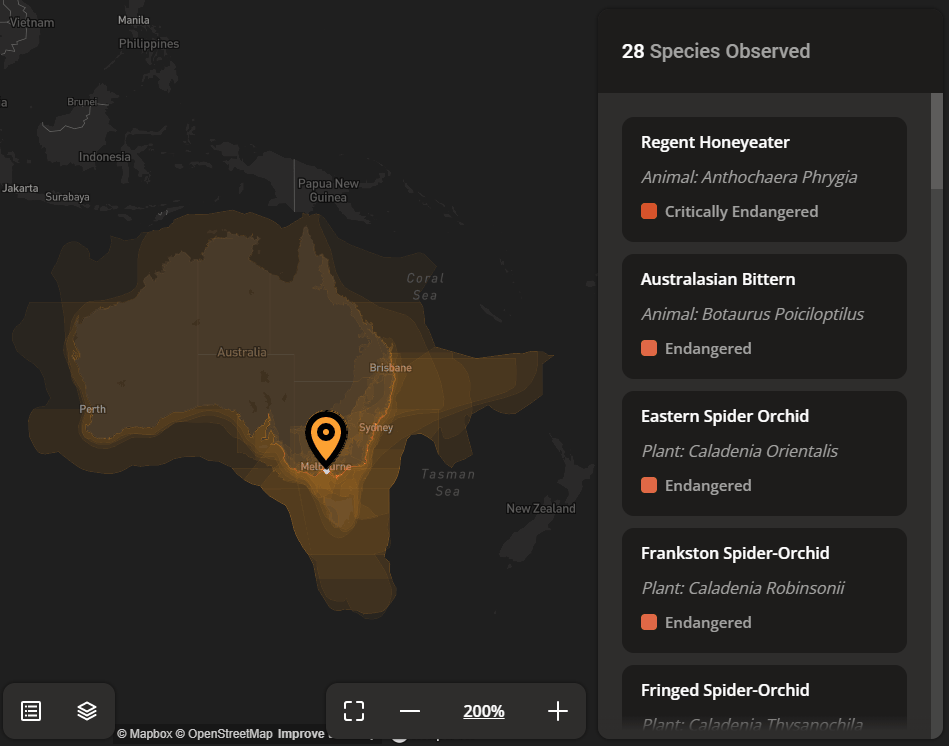Sable

Sable is a supply chain sustainability application developed by Jake and his team at the CSIRO. It allows businesses to add supply chain and operational data which is then used to analyse environmental impacts and opportunities.

Importing is possible for large quantities of data but editing and comprehension of input / results still requires an efficient and compelling visual interface. Jake was responsible for programming tools that allowed for directly drawing to and interacting with maps.

You can see some of the features Jake implemented on pages 3, 7, and 16 of the Sable feature brochure with additional context. Technologies used include React, TypeScript, Go, Webpack, and PostgreSQL.
StoryDevs

StoryDevs is a website for developers of story-focused video games. Jake programmed the front and back end of the site, along with the design and creation of all graphics, logo, UI, and user experience considerations.
The majority of the site is custom made: from its content management system to authentication. The backend technologies are Go, PostgreSQL, TOML, and some small bash scripts, all running on Ubuntu.
StoryDevs' frontend is vanilla HTML, CSS, and JavaScript. The biggest achievement here is the WYSIWYG editor written from scratch in JavaScript. It is tailored to both desktop and mobile.
Access Terminal Mu

Access Terminal Mu is a fun desktop-only exercise that allowed Jake to demonstrate his React.js and TypeScript abilities. It takes the form of a short epistolary fiction with a novel UI.
Full repository available here.
JPEG/PNG Privacy Tool
Often times images are saved with metadata such as the name of the person who took a photo, coordinates of the photo, etc. Jake realised that users uploading images to StoryDevs may inadvertently reveal more than they intended if they weren't aware of this sometimes automatic process.
// Get a file handle. Anything
// that implements the Read and
// Seek methods will work.
f, err := os.Open("image.jpg")
if err != nil {
log.Fatal(err)
}
// Create the map that will hold
// the replacement metadata and
// populate it with known tags.
m := make(jpegutil.Meta)
m[jpegutil.MetaArtist] = "Jake Bowkett"
// Supply ReplaceMeta with the
// file and metadata map.
r, err := jpegutil.ReplaceMeta(f, nil)
if err != nil {
log.Fatal(err)
}The jpegutil and pngutil packages he authored provide a simple function for removing or replacing metadata. This required detailed knowledge of both file formats as well as low-level concepts such as byte order.
The tools are written such that they do not copy the images and waste memory unnecessarily. Instead, a meta structure is created that marks the indices where metadata that is to be removed or spliced in resides. When it comes time to write the file these portions are simply skipped over or added in as needed.
Auto Hyphenation Tool
Web browser support for nicely formatted text is quite poor. Justified text, like columns in a magazine or the pages of a novel isn't seen often online. More likely is a right margin thats jagged and uneven like a worn saw blade.
When it does appear one quickly understands its rarity: words are stretched far too much apart on one line only to be squished the next. Jake's reason for creating this tool is to rectify the main cause of that ugliness: the inabilty of browsers to partition words to allow for a more even distribution of 'word chunks' per line.
Browsers will allow words to be broken if a shy hyphen (an invisible character that tells the browser "it's okay to have a line break here") is placed within them. However with any significant body of text this is impractical to do by hand.
This package can be fed text offline which is useful for content you know won't change regularly. It's not perfect and would need to be accompanied by more complex algorithms to get a book-like layout. Nonetheless it's a significant improvement — try toggling the hyphenation off and on with the button at the start of this section.
StoryDevs, Mu, and this site use the hyphenation tool.
Auto Retry Tool
Since the StoryDevs database policy is very strict about data consistency it's possible for operations to fail if they attempt to act concurrently on the same data. Jake developed the retry package to address the need to retry operations later if they fail under certain conditions (such as a busy database).
There were a few subtleties involved in creating this tool. The first being the need to "back off" exponentially — retrying a given operation after a progressively longer and longer period if it continued to fail. Chances are if an operation has failed three times in the past 30ms it will fail again if the program blindly tries it again after another 10ms. Therefore the gap must grow with each attempt to give time for something to change that will allow tue operation.
The next concern is adding in jitter — a little bit of randomness to the wait time between attempts. If there were 10,000 requests being made to the database, each it's own operation and each trying to act on the same data, 1 would succeed and 9,999 would fail. Then they'd all wait for the exact same interval and try again, mutually blocking each other. By randomising the wait times a little many of the operations will slip inbetween each other like playing cards being shuffled.


